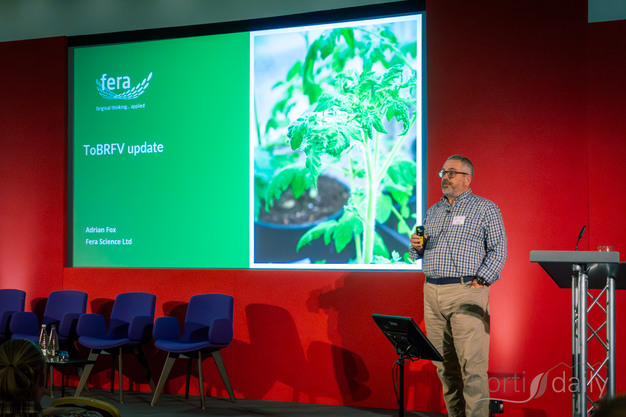The only real solution against ToBRFV is resistant varieties. That was emphasized last week by Simon Conway, president of the British Tomato Growers Association, during the British Tomato Conference. While old favourite varieties may have the flavour retailers and consumers love, Simon emphasized continuing with them is a massive financial risk, with outbreaks on the rise—five in the UK this year alone, the highest ever.
 © Arlette Sijmonsma | FreshPlaza.com
© Arlette Sijmonsma | FreshPlaza.com
The Britsh Tomato Conference is always an event well visited by growers and breeders, but this year more retailers than ever were also welcomed. Simon Conway, representing the UK tomato growers, reached out to them directly to address the issue with the resistant varieties. Despite these being available and offering protection to growers, retailers prefer the non-resistant ones as they offer stronger taste profiles.
"There are the old favorite tomato varieties that we all love and know. But if you're continuing with those, growers are taking a massive financial risk of losing their crop." Simon emphasized breeding is catching up, and the resistant varieties are getting better every day. "Soldiering on with the old varieties is going to cause growers to go out of business."
Integrated management
His comments followed the speech of Adrian Fox, Senior Plant Virologist at laboratory Fera Science Limited. He provided both a domestic update and insight into international developments and research. Adrian's briefing framed resistant varieties as one component of an integrated management plan, and advised growers to combine resistant varieties with hygiene, monitoring, and sanitation practices to reduce the risk of outbreaks and reinfections.
Adrian explained that out of the five outbreaks, two are new in 2025—one detected through the annual APHA survey and one from a grower-submitted sample. Two sites are classified as reinfections and will remain positive until a full season-clear is confirmed, while one site is currently in the process of eradication, pending the end of the cropping cycle.
Other than in the EU, where ToBRFV is treated as a regulated non-quarantine pathogen (RNQP), focusing on controls for seeds and plants for planting rather than mandatory eradication, ToBRFV remains a quarantine pathogen in the UK, meaning it's obligatory to report it. Fera works with growers to prevent reinfection, rather than immediate eradication.
Internationally, ToBrfv outbreaks continue in Australia, which has moved from eradication to management, and Egypt, which now has officially confirmed cases after years of uncertain reporting. Fera is sharing virus survival and management research with international plant health authorities, including in New Zealand and Australia.
 © Arlette Sijmonsma | FreshPlaza.com
© Arlette Sijmonsma | FreshPlaza.com
Seed-Level Controls
Fera tests 3,000 seeds per lot for ToBRFV. Last year, only a single positive was recorded. "It's a testament to the seed industry that the supply chain is as clean as it can be," Adrian noted. While testing cannot guarantee absolute absence, growers can minimize risk by sourcing certified clean seed and maintaining strict hygiene during handling.
Soil Survival Research
Ongoing research under a U FRESCO–led project focuses on ToBRFV survival in soil. Experiments use contaminated soil stockpiles with roots left intact to test virus persistence. Findings show soil can remain infectious for at least 70 days. By 200 days, molecular tests still detect viral genome fragments, but bioassays indicate the virus is no longer infectious.
Adrian highlighted the importance of interpreting these results carefully: "Are we picking up a fragment of the genome or something viable? That distinction matters for practical management decisions."
Current bioassays use local lesion hosts such as tobacco plants. Experiments with systemic hosts like Nicotiana benthamiana have demonstrated detection at tenfold lower virus levels, offering a more sensitive method for monitoring virus presence. Fera is also developing long-range sequencing approaches to detect whole viral genomes quickly, complementing biological tests and providing faster decision-making tools.
Guidance for growers
Based on the current UK outbreaks and ongoing research, the 'Start Clean, Stay Clean' continues to be the advised strategy. "Use certified virus-free seeds and transplants. Ensure propagation and transplanting areas are rigorously sanitized." Incorporating resisstance strategically is next. "Where resistant varieties are available, integrate them into crop planning as part of a systems-level approach. Resistance alone is not sufficient without hygiene and monitoring."
Then, there's the end-of-season clean-up, when it's important to thoroughly remove plant debris and sanitize growing media between crops to prevent inoculum build-up. Soil contamination can persist for at least 70 days, so season-end sanitation is critical.
"Conduct regular inspections and testing", Adrian added about the monitoring of crops. "Be aware that PCR-based tests may detect genome fragments that are not infectious, but early detection of viable virus allows timely intervention." He emphasized the importance of working with authorities. "Report suspected outbreaks to inspectors promptly. Collaboration supports both immediate containment and long-term prevention strategies.
Ongoing Information Resources"
Fera is updating its online ToBRFV hub to consolidate research, surveillance data, and practical guidance. "The aim is to create a living hub of information," Adrian said, enabling growers and the seed industry to access current findings and recommended management practices.
